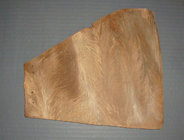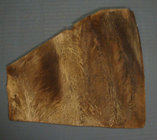Years ago, some friends of mine made their once-in-a-lifetime vacation to Hawaii, thanks to another friend loaning them a condo in Kona. While driving around seeing the sights, instead of doing the standard tourist stuff, they came across a one man sawmill, and ended up spending the day there, learning about Hawaiian woods. They were given some cutoffs and sent them to me to make something out of. There were a couple chunks of Koa, a chunk of what I later learned was mango, and a slim end cut of milo. I made a couple of calabashes, by mainland definition, and a puahala or two, and I'm still thinking what to do with the milo. Not long ago, I discovered a bagged chunk of wood that I didn't recall, and when I unbagged it, found it's obviously another chunk of Hawaiian wood. I assumed it was Koa, and dry, and took it out of the bag, planning to make another calabash (proper Hawaiian shape this time), but it was impossible to tell what direction the grain was running as the chunk was just dark black all over.
Today, I sliced a slim piece off what I thought was the end, but it turned out to be face grain wood, and probably not Koa. Taking into consideration the smudging from a prolonged time in a bag, I wonder if this is actually pheasantwood. Would you Hawaiian turners, or those Floridians who have seen both, please advise whether it's Koa or pheasantwood, or something else? (first picture is raw, second picture is after applying mineral spirits to show the grain better, though it mostly just brought out the spalting)
Thank you!


Today, I sliced a slim piece off what I thought was the end, but it turned out to be face grain wood, and probably not Koa. Taking into consideration the smudging from a prolonged time in a bag, I wonder if this is actually pheasantwood. Would you Hawaiian turners, or those Floridians who have seen both, please advise whether it's Koa or pheasantwood, or something else? (first picture is raw, second picture is after applying mineral spirits to show the grain better, though it mostly just brought out the spalting)
Thank you!


